Why Proper Laundry Room Plumbing Matters
Laundry room plumbing is a critical system that handles massive amounts of water. The average washing machine uses 41 gallons of water per load, meaning a typical family cycles over 80 gallons daily through these pipes.
Essential laundry room plumbing components include:
- Water supply lines: Hot and cold connections with shut-off valves
- Standpipe: An 18-30 inch tall, 2-inch minimum diameter pipe for drainage
- P-trap: A bend in the pipe that prevents sewer gases from entering your home
- Washing machine outlet box: A recessed box that houses connections and shut-offs
- Utility sink: Requires its own supply lines and drain connection
- Floor drains: Optional but recommended for overflow protection
Correct installation prevents costly water damage, ensures proper drainage, and protects your home from flooding. In contrast, poor installation can lead to burst hoses, sewer gas leaks, and expensive repairs. Behind every load of clean clothes is a complex network of pipes and valves that must work perfectly.
This guide covers everything you need to know about laundry room plumbing, from basic components to installation and maintenance, ensuring a safe and efficient system.

Simple guide to laundry room plumbing:
The Anatomy of Laundry Room Plumbing
Your laundry room plumbing involves a precise system for water intake and drainage. When every component works correctly, your laundry day runs smoothly.
Essential Water Supply Components
Your washing machine requires a reliable supply of hot and cold water. This system begins at your home's main water supply and runs through the walls via copper pipes or PEX tubing. While copper is traditional and durable, flexible PEX tubing is often preferred because it resists corrosion and is easier to install.
These supply lines end at 1/2-inch hot and cold connections for your washing machine. Each connection must have its own shut-off valve, which is your first line of defense against flooding from a burst hose.
A washing machine outlet box is a recessed wall unit that neatly houses the shut-off valves and connections, providing a clean, professional look and easy access for maintenance.
The final connections are the hoses. Always choose braided steel hoses over standard rubber ones. They are far more durable and less likely to burst, preventing thousands of dollars in potential water damage.
Water hammer arrestors are small devices that absorb the pressure shockwaves created when your washer's water flow suddenly stops. They prevent the loud banging noise known as water hammer and protect your pipes from damage.
Critical Drainage Components
The drainage system is just as important as the water supply. The standpipe is the vertical drain pipe for your washing machine, and its height is critical—it must be between 18 and 30 inches tall to prevent both overflows and siphoning.
The P-trap is a U-shaped bend in the drainpipe that holds a small amount of water. This water acts as a barrier, blocking unpleasant sewer gases from entering your laundry room.
Proper venting is essential for smooth drainage. A vent pipe connects to your drain line and runs outside (usually through the roof), allowing air to enter the system. This prevents a vacuum from forming, which would otherwise cause slow drains and siphon water from the P-trap.
While not always required, floor drains are excellent insurance against catastrophic water damage. A 2-inch floor drain, with the floor sloped towards it, can safely channel away water from a major leak or overflow.
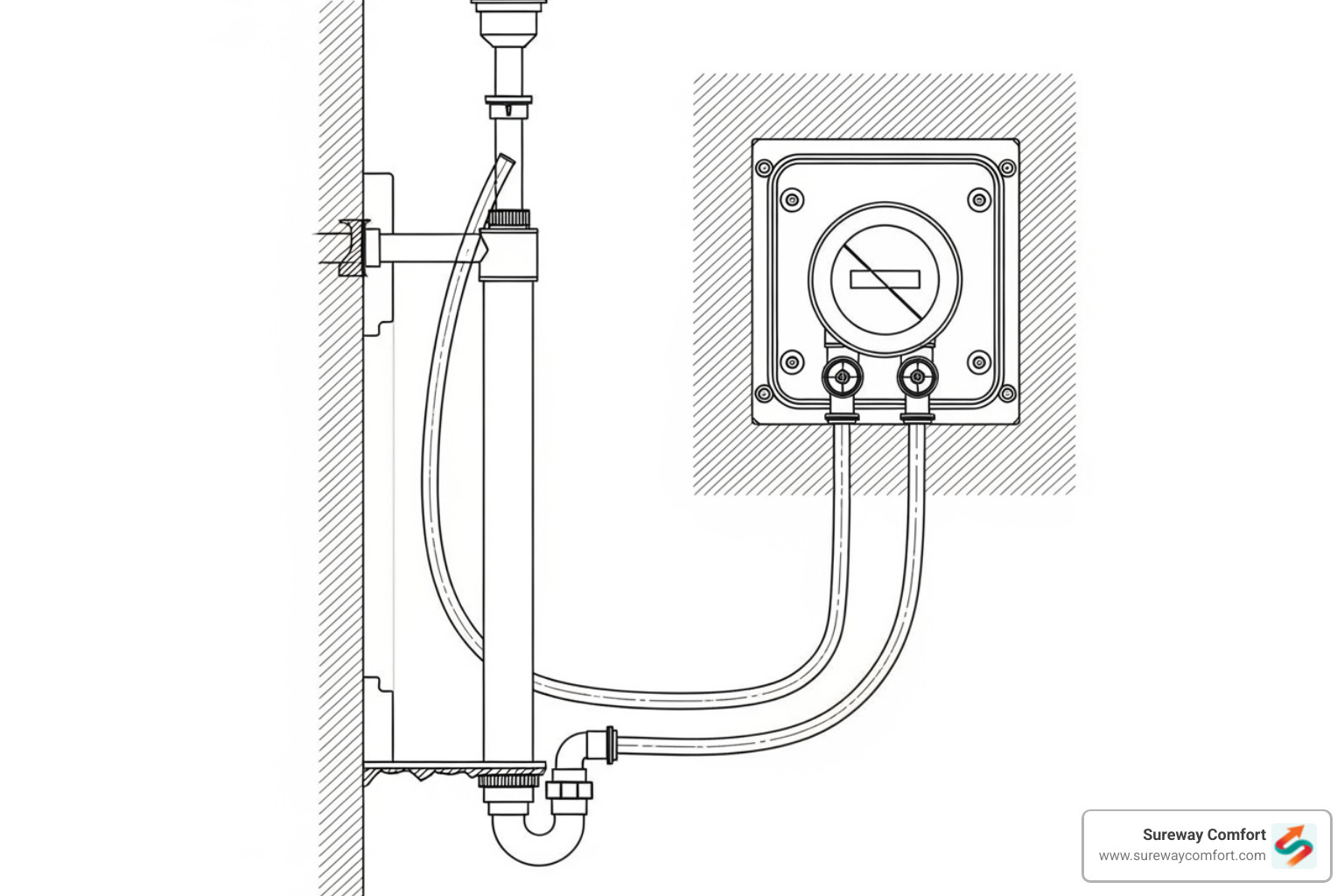
Basically, something like this... (Source: https://i.sstatic.net/0HUVn.jpg)
A Step-by-Step Guide to Laundry Room Plumbing Installation
Proper laundry room plumbing installation is key to a reliable, long-lasting system. Careful planning and execution will prevent future headaches.
Planning the Layout
Upfront planning prevents costly mistakes and ensures your laundry room is efficient.
- Measure your space: Record the room's exact dimensions, including doorways, windows, and any obstacles. This ensures your appliances and fixtures will fit.
- Appliance placement: Position the washing machine near existing water lines and drains, leaving enough room for access and maintenance. The dryer's location will be determined by its need for external ventilation.
- Choose the right materials: We recommend PEX tubing for flexible, corrosion-resistant water supply lines. For drain lines, ABS or PVC pipe are durable and affordable choices.
Connecting Your Washing Machine
Getting these connections right is critical for preventing leaks.
- Connect supply hoses: Attach braided steel hoses from the washer box valves to your machine's hot and cold inlets. Hand-tighten, then use a wrench for a final quarter-turn. Do not over-tighten.
- Secure the drain hose: Insert the washer's drain hose about 6 to 8 inches into the standpipe. This depth prevents both splashing and siphoning.
- Level your machine: Use a level and adjust the machine's feet so it sits perfectly flat. A level machine runs quieter, vibrates less, and experiences less wear and tear.
Integrating a Utility Sink
A utility sink is a great addition for handwashing, soaking, or general cleanup.
- Tap into supply lines: We can branch off the washer's existing supply lines or run new ones from the main water supply, depending on your layout.
- Install the faucet: Choose a faucet with a high spout to accommodate large items like buckets. Secure it to the sink and connect the supply lines.
- Set up the P-trap: The U-shaped P-trap sits below the sink drain to block sewer gases.
- Connect to the main drain: The sink's drain must connect to the main drain line. Proper sizing and venting for both the sink and washer require professional expertise.
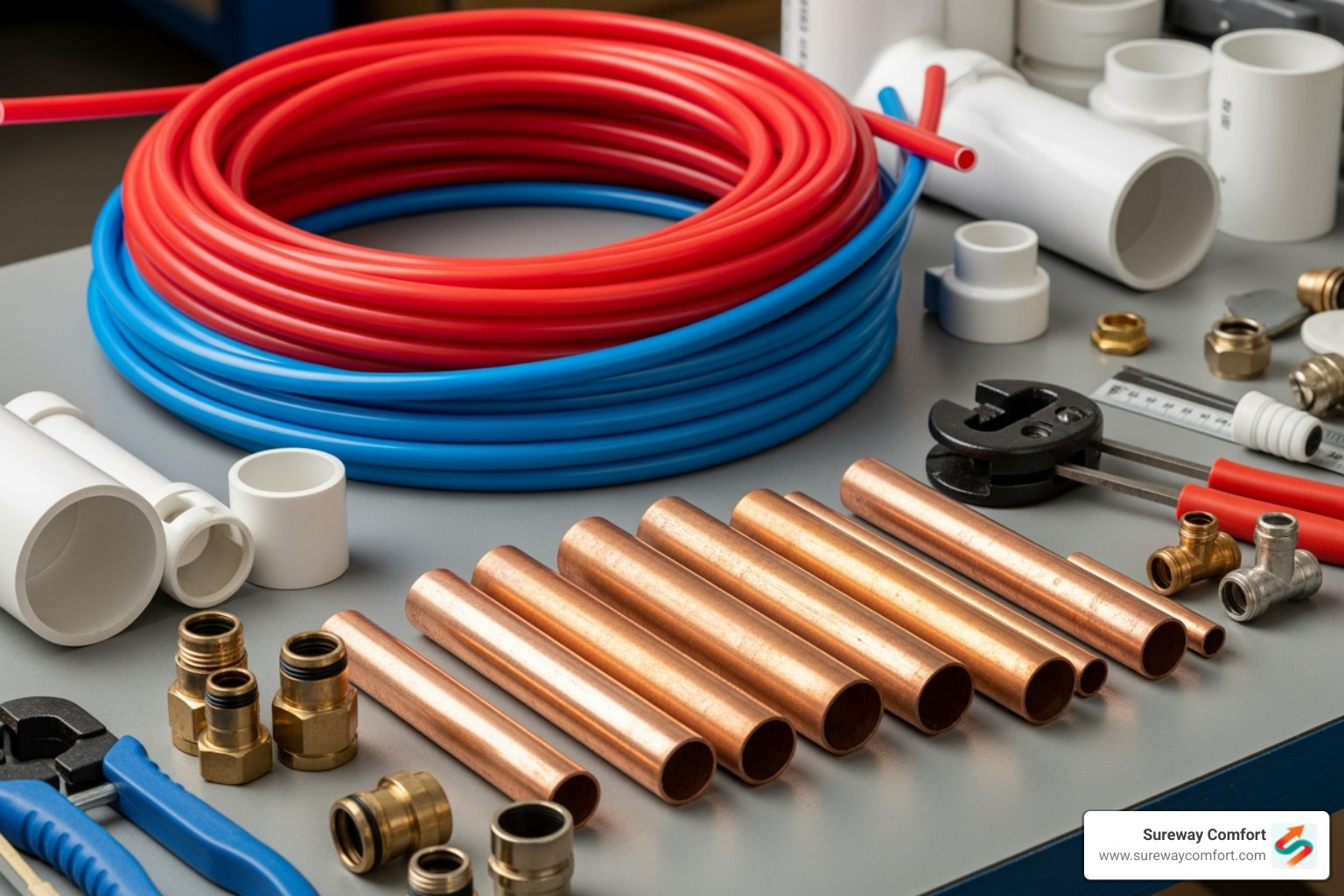
Optimizing Your Layout for Space and Efficiency
Smart design can make even small laundry rooms highly functional.
- Vertical space utilization: Stack your washer and dryer to free up floor space for a utility sink or storage.
- Compact fixtures: Consider smaller or wall-mounted utility sinks that save space.
- Concealing plumbing: Hide supply and drain lines in custom cabinetry for a clean, finished look while keeping them accessible.
- Planning for future needs: If you might add a water softener or filter later, planning for those connections now saves time and money.
When your project gets complex, Sureway Comfort has the expertise to ensure a professional, code-compliant installation.
Essential Codes, Safety, and Best Practices
Proper laundry room plumbing isn't just about function—it's about safety and legality. Plumbing codes are your home's safety net, protecting you from sewer gas, leaks, and floods. In the Bridgeville, PA area, we adhere to strict local codes that align with national standards like the Universal Plumbing Code (UPC).
Key Plumbing Codes and Regulations
- Standpipe height: The standpipe opening must be between 18 and 30 inches above the P-trap. This prevents overflows and ensures your washer's pump doesn't have to work too hard.
- Drain pipe diameter: A washing machine requires at least a 2-inch diameter drain pipe. If a utility sink shares the line, the pipe may need to be 3 inches.
- P-trap placement: The P-trap must be installed correctly to hold water and block sewer gases. It also needs to be accessible for cleaning.
- Proper venting: Every drain needs a vent (typically 1-1/4 inches or larger) to allow air into the system for smooth, gurgle-free drainage.
- Dryer vent requirements: Your dryer vent must be a 4-inch diameter smooth metal duct. The total length cannot exceed 35 feet (with reductions for each bend), and it must terminate outside your home, never in an attic or crawl space.
Electrical and Safety Requirements
Because laundry rooms combine water and electricity, safety is paramount.
- GFCI protection: GFCI outlets are required for all receptacles in a laundry room. They instantly cut power if a fault is detected, preventing electrical shock.
- Dedicated circuits: Your washing machine needs a dedicated 20-amp, 120-volt circuit. An electric dryer requires a more powerful dedicated 30-amp, 240-volt circuit.
- Leak pans: For laundry rooms on an upper floor, a leak pan under the washing machine is essential. It catches leaks and directs water to a drain, preventing damage to the ceiling below.

Common Mistakes to Avoid
Most plumbing mistakes are preventable. Here are the most common ones to avoid:
- Improper venting: Leads to slow drains, gurgling sounds, and sewer smells.
- Incorrect pipe slope: Drain pipes need a 1/4-inch per foot downward slope. Too flat, and they clog; too steep, and solids are left behind.
- Using flexible plastic dryer vents: These are a serious fire hazard because they trap lint and can ignite. Always use smooth metal ducting.
- Over-tightening connections: This can strip threads or crack fittings, causing leaks.
- Ignoring local codes: This can lead to failed inspections and create serious safety hazards.
To ensure your laundry room plumbing meets all codes and safety standards, contact Sureway Comfort today for professional installation.
Maintaining Your System & Troubleshooting Common Issues
Your laundry room plumbing is a workhorse, handling thousands of gallons of water annually. Just like a car, it needs regular maintenance to run smoothly and prevent major water damage.
Preventative Maintenance Checklist
Regular checks are your best insurance against plumbing emergencies. Follow this simple schedule:
- Inspect washing machine hoses every six months. Look for bulges, cracks, or leaks. Replace standard rubber hoses every 3-5 years as a precaution. We recommend upgrading to braided stainless steel hoses, which are more durable, but even they should be replaced if they show signs of wear.
- Clean lint filters regularly. Check your washer's manual to locate its filter. Clean your dryer's lint trap after every load to improve efficiency and prevent fire hazards.
- Flush drain lines monthly. Pouring a bucket of warm water down the standpipe helps clear soap scum and lint buildup that can cause clogs and odors.
- Watch for slow drainage. If water backs up in your standpipe or sink, it's a sign of a forming clog that should be addressed immediately.
- Set your water heater to 120°F. This temperature is effective for cleaning while protecting the rubber components in your hoses from premature wear.
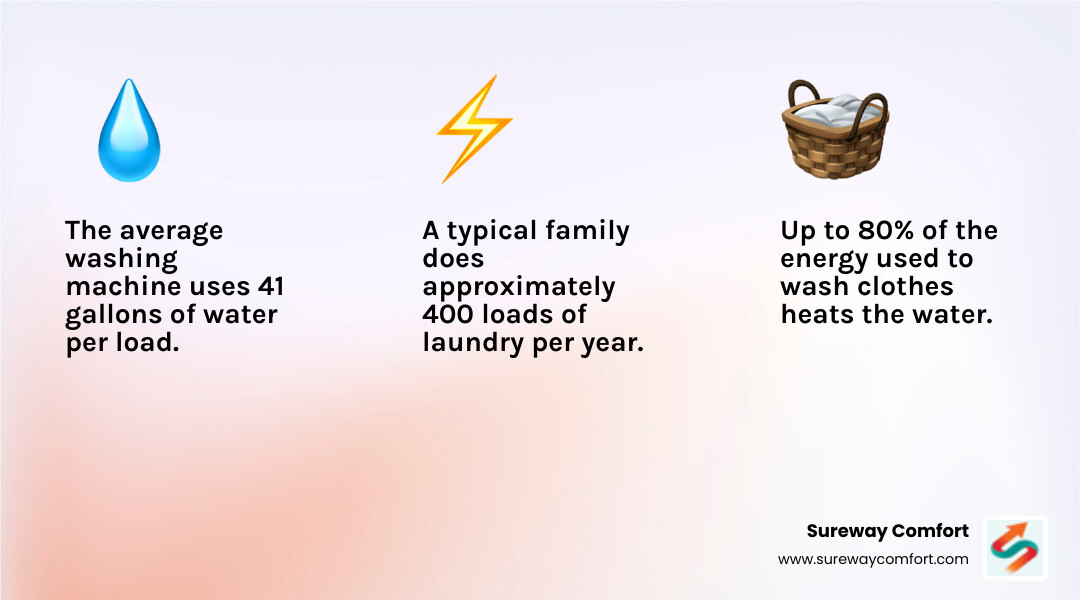
(Source: https://www.nps.gov/articles/laundry.htm)
Common Laundry Room Plumbing Problems and Solutions
Even with good maintenance, issues can arise. Here's how to handle the most common ones:
- Slow drains and clogs: Often caused by a buildup of lint and soap scum in the P-trap. A plumbing snake may clear a minor clog, but persistent blockages require professional service.
- Leaking hoses: A puddle behind your washer indicates a leak. Sometimes it's a loose connection, but worn-out hoses must be replaced immediately. Upgrade to braided stainless steel for better durability.
- Water hammer: This is an alarming banging sound in your pipes when the washer fills or stops. Installing water hammer arrestors on the supply lines will absorb the pressure shockwaves and solve the problem.
- Foul odors from your drain: A sewage smell usually means the P-trap has dried out, allowing sewer gases to escape. Pouring a gallon of water down the drain will refill it. You can also run a cleaning cycle with vinegar and baking soda. Persistent odors may signal a deeper venting issue.
The Benefits of a Professional Plumber
While some tasks are DIY-friendly, calling a professional is the smart move for complex jobs.
- Code Compliance: We stay current on all local codes in Bridgeville, PA, and surrounding areas to ensure your plumbing passes inspection.
- Preventing Water Damage: Our experienced technicians can spot potential problems before they turn into catastrophic leaks.
- Complex Layouts: We have the expertise to design and install reliable plumbing for any home, old or new.
- Warranty Protection: Many fixture warranties require professional installation to remain valid.
- Peace of Mind: Knowing your plumbing is installed and maintained correctly lets you focus on other things.
Ready to get your laundry room plumbing in top shape? Contact Sureway Comfort today for professional maintenance and repairs.
Frequently Asked Questions about Laundry Room Plumbing
Here are answers to the most common laundry room plumbing questions we receive from homeowners in the Bridgeville, PA, area.
How often should I replace my washing machine hoses?
This is critical for preventing water damage. We recommend replacing standard rubber hoses every 3 to 5 years, as they can become brittle and burst unexpectedly.
Braided stainless steel hoses are a much more durable option, typically lasting 8 to 10 years. However, you should still inspect them annually for any signs of wear, bulges, or cracks at the connections. If you see any damage, replace them immediately. To help keep track, write the installation date on a piece of tape on the hose.
What is the banging noise I hear when my washer stops filling?
That loud banging sound is called water hammer. It's caused by the shockwave created when the water flowing through your pipes is suddenly shut off by the washing machine's valve. Over time, this repeated stress can damage pipes, joints, and valves.
The solution is to install water hammer arrestors on your hot and cold water supply lines. These small devices act as shock absorbers, safely dissipating the pressure and eliminating the noise.
Can I install a laundry room on the second floor of my home?
Yes, a second-floor laundry room is a convenient option, but it requires careful planning to prevent water damage. Most building codes require a leak pan with a proper drain installed under the washing machine. This pan will catch and drain away any water from an overflow or burst hose, protecting the rooms below.
Other considerations include ensuring the floor structure can support the weight and vibration of the appliances and verifying that the water pressure and drainage systems are adequate. We have extensive experience installing second-floor laundry rooms that meet all local codes and safety requirements.
If you're considering an upstairs laundry room, contact Sureway Comfort today for a consultation. We'll create a safe and efficient laundry room plumbing system that gives you convenience and peace of mind.
Conclusion
Your laundry room plumbing is a hardworking system, and understanding its key components—from supply lines and P-traps to standpipes and proper venting—is the first step to keeping it running smoothly.
Proper installation is the foundation of a safe, efficient system. This means following code requirements for standpipe height and drain pipe size, using durable materials like braided steel hoses, and installing water hammer arrestors to protect your pipes.
Regular maintenance, such as inspecting hoses and cleaning filters, can prevent most common problems. When issues like slow drains or leaks do arise, addressing them quickly protects your plumbing and your home from costly damage.
While some maintenance is DIY-friendly, complex installations and repairs require professional expertise to ensure code compliance, protect warranties, and guarantee safety. At Sureway Comfort, our experienced technicians provide proper installation and maintenance, saving homeowners from water damage and ensuring years of reliable service.
Don't let plumbing problems wash away your peace of mind. For reliable and code-compliant laundry room plumbing services in the Bridgeville, PA area, including South Fayette, Upper St. Clair, Mt. Lebanon, McDonald, Scott Township, Canonsburg, and Bethel Park, contact Sureway Comfort today!




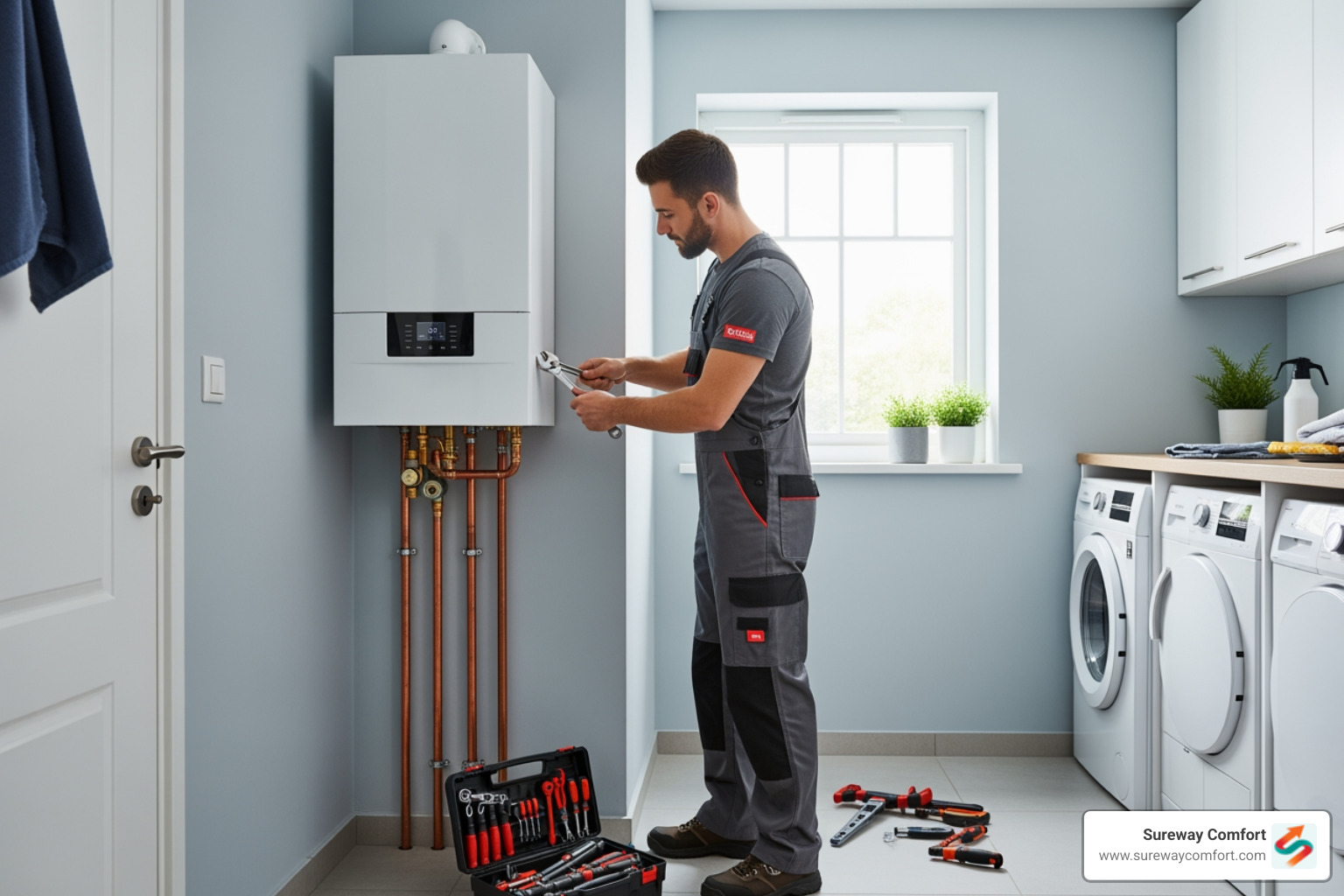

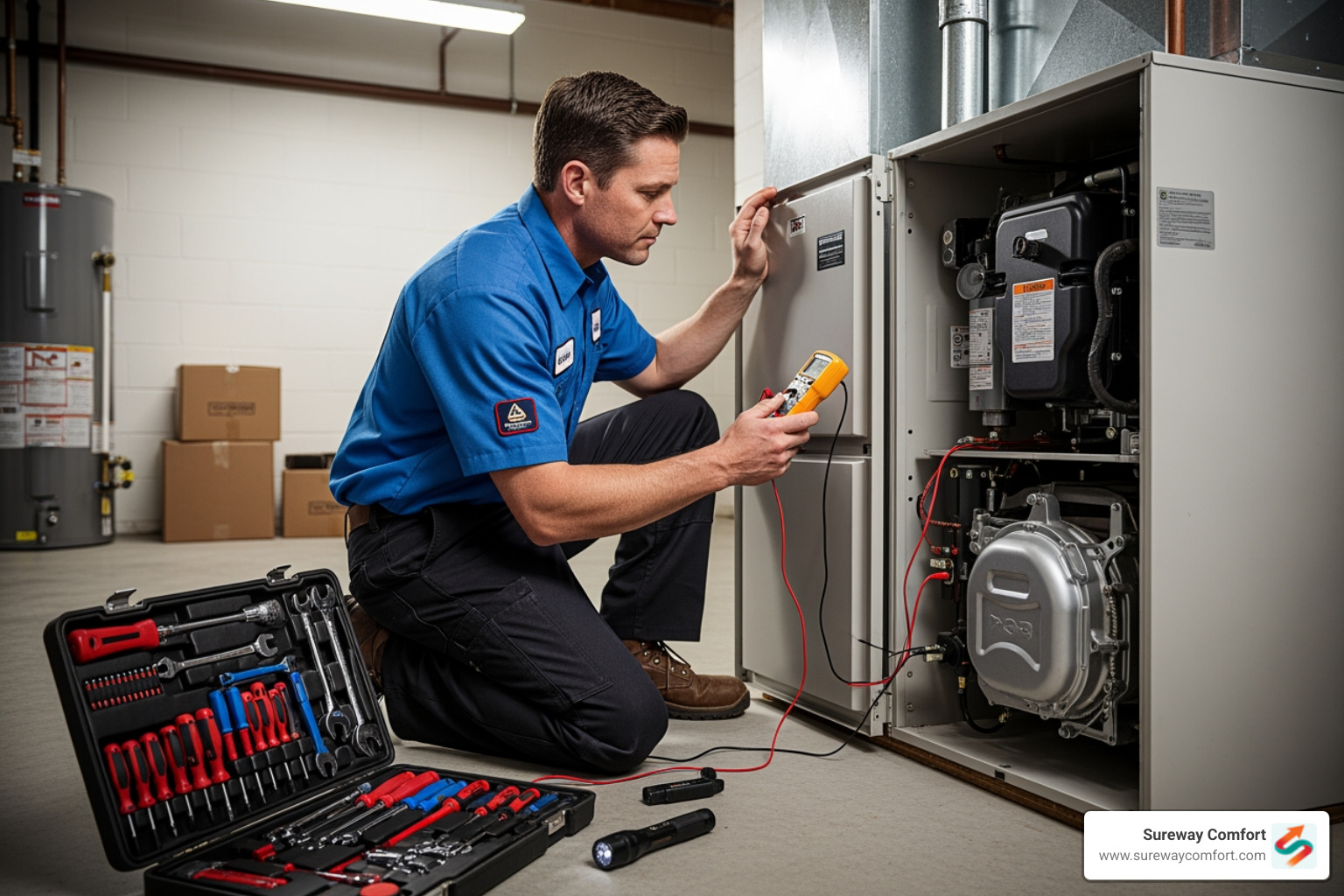
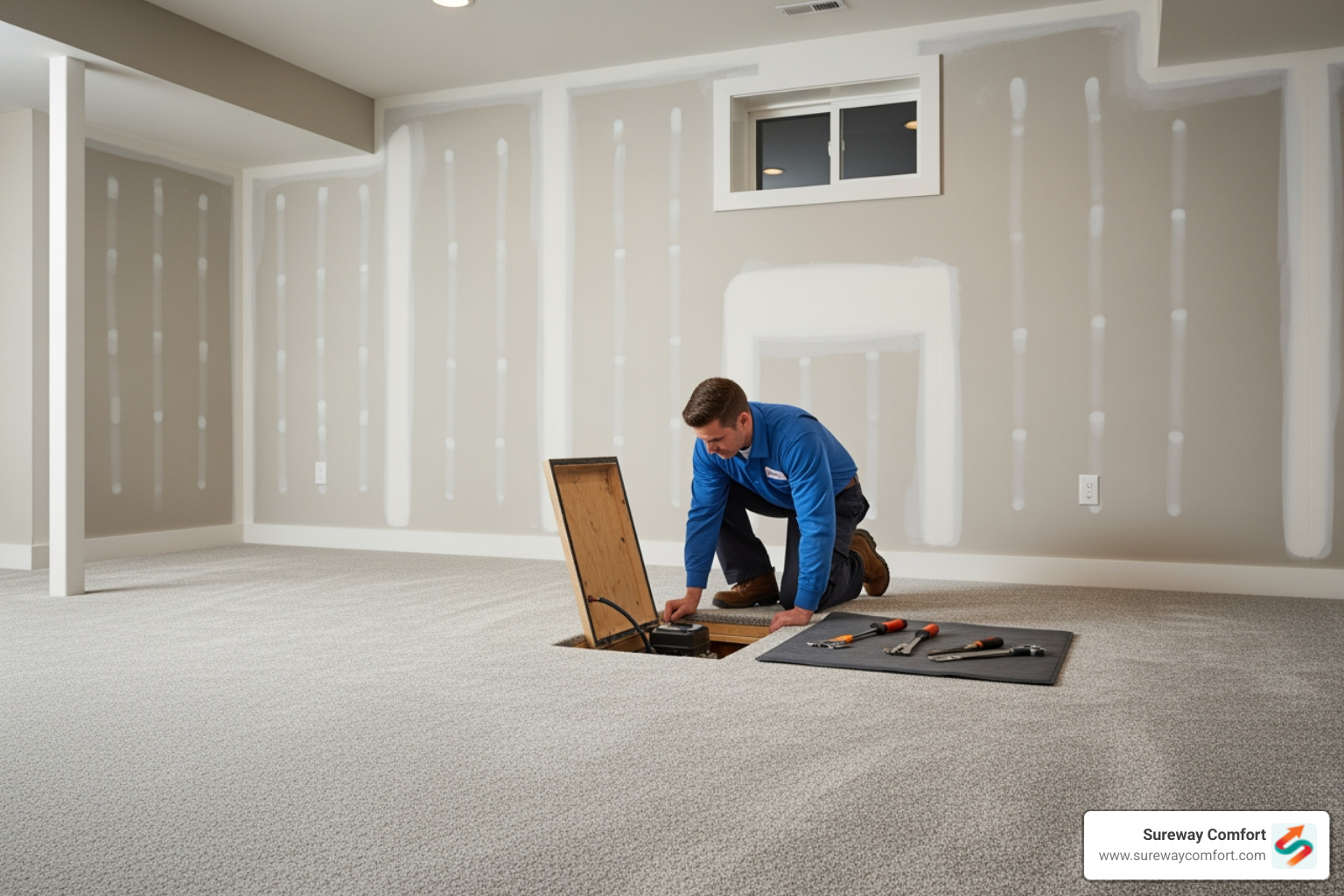




















.avif)



